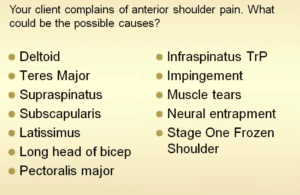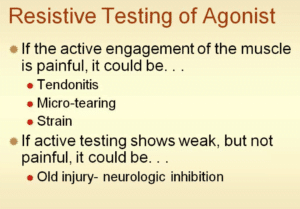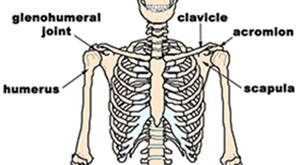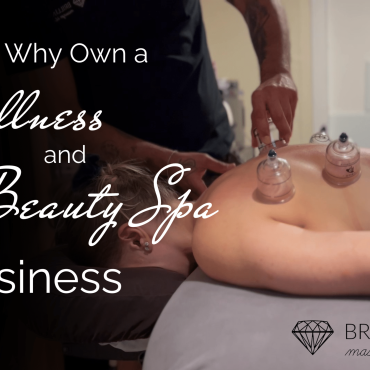Shoulder Pain
Whether you pull a muscle, have an overuse injury or strain, or are dealing with any number of issues, one thing typically remains true: You never really understand how much you use your shoulder, or knee until you’re dealing with chronic pain.
Shoulder Pain causes is hard to pin point. One of the causes of shoulder pain is Rotator Cuff injuries, tendonitis, muscle tears (partial tears usually more painful than full tears), arthritis, impingement. Often it is truly hard to access which muscle(s) actually causes the imbalance, pulls, is tight etc, however it is necessary to keep searching, hand dominance usually makes no difference for pain occurence.
What Is a Rotator Cuff Injury?
The shoulder is a highly mobile structure made up of several joints and muscles. One of the main joints is formed where the collarbone (clavicle) and the top edge of the shoulder blade (acromion) come together. Another main joint, the glenohumeral joint, formes where the end of the upper arm (humerus) comes together with the outer edge of the shoulder blade (scapula)(Gray, 1995).
For example these are the reason that could be causing anterior shoulder problems:



Rotator Cuff
Each of the rotator cuff muscles originate from the shoulder blade and attaches to various parts of the upper arm. For the rotator cuff to work correctly, the shoulder blade needs to remain fairly stable and act as an anchor for these muscles during movements involving the arm. Conversely, the arm must have the ability to rotate freely in the glenohumeral joint so that when the arm is moving, the shoulder blade does not have to compensate and lose its steady position on the rib cage (Cook, 2010). Ideally, this relationship of stability and mobility limits the likelihood that rotator cuff muscles will become injured and/or strained during movements of the shoulder and arm.
Causes
Unfortunately, there are many environmental conditions and musculoskeletal compensations that can affect the stability of the shoulder blade and mobility of the arm in the glenohumeral joint (Price and Bratcher, 2010). For example, focusing on a computer or television screen requires you to constantly adjust your eyes. This typically results in your head jutting forward of its optimal position to read text and watch or look at the images in front of you. This forward head position pulls the shoulder blades up and forward of their optimal position on the rib cage via the upper fibers of the trapezius muscle (which originate on the top of the shoulder blade and attach to the head).
The prolonged seated postures that normally accompany computer use or TV watching also affect the position of the shoulder blades. They move outward and away from the spine when the spine and rib cage drop forward during these activities (Kendall, McCreary and Provance, 1993). Habitual movements of the upper back, head and neck to one side of the spine can also affect the position of each shoulder blade. Routinely carrying a bag or purse on one side of your body, cocking your head to one side to talk on the phone, handedness or musculoskeletal compensations for an imbalance elsewhere in the body can all pull the shoulder blade(s) out of alignment via the muscles that run from the shoulder blade to the thoracic spine, head and neck (e.g., rhomboids, trapezius, levator scapulae).
Stress
Stress can also affect the stability of the shoulder blades. When a person is experiencing high levels of stress, innate self-protection measures kick in. This initiates a dropping down of the rib cage at the front to protect our organs from real or perceived threats. This dropping of the rib cage has many effects on the position of the shoulder blades. The rib cage attaches to the thoracic spine, which means that the down and forward movement of the rib cage causes the thoracic spine to round forward and move the shoulder blades out of alignment. The clavicle (which helps create the joint at the top of the shoulder with the acromion) involves in the formation of the sternocalvicular joint where it attaches to the rib cage/strenum.
As such, when the rib cage drops down and forward, it pulls both the clavicle and the top of the shoulder out of alignment.
Immobility is a factor
While instability of the shoulder blades can be a major contributor to rotator cuff injuries, immobility of the arm in the glenohumeral joint is another factor that can lead to rotator cuff pain and dysfunction. In today’s society we are constantly using our hands for fine motor control skills to engage in activities like typing, texting, needlework, crafts or playing musical instruments. Exercising with equipment that requires us to grip handles is also a constant demand on the muscles and fascia that control our hands and wrists. These tissues of the lower arms interconnects with the muscles and fascia of the upper arms and shoulders. Over time, restrictions in the tissues and muscles of the hands, wrists and forearms can affect the function of the structures in the upper arms and shoulders and limit mobility in the glenohumeral joint (Myers, 2001).
How Massage Can Help
A torn rotator cuff or dislocated shoulder can make it difficult to move your arm, but so can simply sitting in one position for too long. No matter what causes the stiffness or soreness, shoulder massage is an effective way of increasing your range of motion. That’s because it increases the supply of fresh blood to your muscles, providing them with oxygen-rich nutrients.
Restoring the gliding range of motion, and soothing and freeing overworked muscles that have been beat up by working with the wrong line of pull, is where massage therapy really shines.
Deep tissue massage, which works across the grain of your muscles, or Swedish massage, which works with the grain, can provide relief of tension, stiffness and pain.
Massage Therapists Help
Massage therapists can manually manipulate muscles thats why they are one of great people that often can help with shoulder pain unless medical care is required.
To be effective, however, massage therapists need to look at the rotator cuff as the core stabilization system for the glenohumeral joint. To determine range of motion involves evaluating the position and fixity of the humeral head itself, and guiding it back to the center of the joint manually. It will often appear that the pecs are tight. But if you put the palms of your hands on the outside of the humeral head and slowly move it posterior/ inferior-ward, you’ll discover that what you’re seeing is an anterior humeral head.
Up, down and side to side are not useful ways to describe shoulder movement. Instead, talk about upward and downward rotation, and scaption (protraction and retraction around the ribcage), which are the real motions that go with arm gesture. All of these movements can be actively and passively coached— for example, when the patient is prone.
Self Massage
There’s no replacement for a professional massage therapist. Even though rubbing your own neck or shoulder with the opposite hand can provide temporary relief, an expert knows how to direct pressure for the best results.
You might feel some lumps giving way under the pressure, which indicates that the muscle and tissue adhesions causing your pain are breaking up. Exercise caution if the tissues are inflamed, but you should know that you can still work on the parts that are not inflamed.
People may start out with a straightforward rotator cuff tear. As that heals symptoms may still be produced by trigger points that cropped up after the injury. This may be the explanation for unusually persistent pain after an injury. It’s not that the injury isn’t healing, but that it’s gradually been replaced by trigger point pain, or greatly exacerbated by it. And so massage of the rotator cuff — and the infraspinatus in particular — may provide surprisingly easy relief from stubborn shoulder “injuries.” Certainly it’s worth a try.
-Jolita Brilliant, LMT, Burlington, VT


